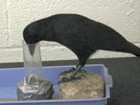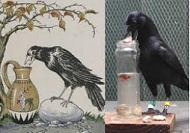 |
"If men had wings and bore black feathers, few of them would be clever enough to be crows."
Henry Ward Beecher
Crow intellect is an old story and many �wives tales� are still floating around out there. It has often been said that crows have the ability to count. The story is usually told about three hunters that go into a blind (under the eye of a few watchful crows) situated near a field where crows often feed. They wait, but the crows refuse to move into shooting range. Two hunters leave the blind, but the crows still won�t budge. When the third hunter leaves, the crows somehow realize that the coast is clear and resume their normal feeding activity. Another �fact� that I have been told many times is that a crow can tell the difference between a farmer with a rake and the same farmer with a gun. Other similar tales abound. Whether or not these are true or just hunting urban legends, the crow definitely has one of the highest natural intelligence levels found in nature. In recent years, scientists and researchers have shown that crows around the world exhibit characteristics generally considered to be indications of higher intelligence such as problem-solving, tool making, complex social structures, cooperative hunting and raising of young, and the ability to play, as well as excellent memory, communication, and even mimicry.
Below are a few items that show something that we crow hunters have known all along, that the crow is an amazing and intelligent creature, not just among other birds, but among the entire animal kingdom.
 Tool Making Crows Tool Making Crows
The New Caledonian Crow (Corvus moneduloides) is a tool-using species of crow endemic to New Caledonia. These crows are able to make hooks, an ability that not even our closest relative, the chimpanzee, has mastered. This species is not just famous for its tool-making abilities. These crows have also solved a number of sophisticated cognitive tests which suggest that this species is particularly intelligent.

click to view this amazing video
|
 "The Crow and the Pitcher" "The Crow and the Pitcher"
 Aesop had a story called "The Crow and the Pitcher" which goes like this: A crow wants some water from a pitcher, but he can't reach it, so he drops rocks into it until the water rises enough for him to get a sip. This of course is a fable, but a recent test done on rooks (a small type of crow) showed that Aesop may not have been far off. In the study, rooks were placed in a room containing a small pile of pebbles, then given a worm in a tube with water and they made sure the worm floated just out of the crow's reach. Two of the birds took two attempts to figure out the trick, and the other two got it on the first try. The mind-blowing part? The birds didn't just figure out a crude behavior through trial and error; they dropped in stones only until the water was high enough to reach the worm, and went for the larger pebbles too, understanding that they would displace more water. Aesop had a story called "The Crow and the Pitcher" which goes like this: A crow wants some water from a pitcher, but he can't reach it, so he drops rocks into it until the water rises enough for him to get a sip. This of course is a fable, but a recent test done on rooks (a small type of crow) showed that Aesop may not have been far off. In the study, rooks were placed in a room containing a small pile of pebbles, then given a worm in a tube with water and they made sure the worm floated just out of the crow's reach. Two of the birds took two attempts to figure out the trick, and the other two got it on the first try. The mind-blowing part? The birds didn't just figure out a crude behavior through trial and error; they dropped in stones only until the water was high enough to reach the worm, and went for the larger pebbles too, understanding that they would displace more water.
|
 Bait & Switch Bait & Switch
Since they are omnivores and opportunists, crows are often thought of as thieves. And because of that when crows have food they want to stash, they always keep an eye out for other crows. If another is watching, the crow will pretend to hide the food in their cache, when in reality, they're stashing it in their chest feathers. Crows have actually learned sleight of hand! Then they will fly off and bury it in another cache. The crazy part; the watching crows have then been observed to follow the hiding crows, because they know that sometimes they pull a bait and switch themselves. |
 Crows using us as tools 1 Crows using us as tools 1
Tony Angell, a northwest naturalist, reports on a Carrion crow in Northern Europe that had observed a pair of ice fishermen working on a frozen lake. As is common practice, flags marked the holes in the ice and when a fish was caught, the flags would snap up, signaling a strike. But before the men could get out on the ice, the crow flew down, grasped the line in its beak, and pulled at it, backing away from the hole. After a short distance it would drop the line, but kept it from slipping back into the water by securing the line with its feet. By repeating the grab-pull-grab-pull action, the crow was finally able to jerk the fish up onto the ice and eat it. This was repeated over and over.
|
 Crows using us a tools 2 Crows using us a tools 2
 On a university campus in Japan, crows and humans line up patiently, waiting for the traffic to stop. When the lights change, the birds hop in front of the cars and place walnuts, which they picked from the adjoining trees, on the road. After the lights turn green again, the birds fly away and vehicles drive over the nuts, cracking them open. Finally, when it�s time to cross again, the crows join the pedestrians and pick up their meal. On a university campus in Japan, crows and humans line up patiently, waiting for the traffic to stop. When the lights change, the birds hop in front of the cars and place walnuts, which they picked from the adjoining trees, on the road. After the lights turn green again, the birds fly away and vehicles drive over the nuts, cracking them open. Finally, when it�s time to cross again, the crows join the pedestrians and pick up their meal.
|
 Crows using other animals Crows using other animals
Tony Angell also reports of an instance where a crow would "use" a squirrel to retrieve food from covered trash cans. The crow wasn�t able to get at the food inside, so it simply waited for a squirrel to push open the swinging lid, rummage around, and emerge with some food. The bird then chased and harassed the squirrel until it dropped the food, which the crow quickly ate. |
 More crow problem solving More crow problem solving
Nature writer Candace Savage relates a story of a problem solving crow being kept by researchers at the University of Chicago. The crow was partly fed with dry food, which it liked moistened. However, sometimes the keepers forgot to add water to the food. The crow, in a spontaneous and untrained act, picked up a small plastic cup that had been provided as a toy, dipped the cup into its water trough, carried the filled cup across the room to the feeder, and emptied the water onto the dry food. |
 Crows having fun! Crows having fun!
On Check out this video of a Jackdaw (European type of crow) sledding for fun. You heard right, sledding! |
|
|
 |

 Smart Crows
Smart Crows